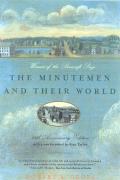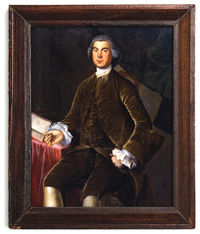Yesterday’s posting introduced
Tilly Merrick (1755-1836), who grew up in
Concord before the Revolutionary War and died in that town decades later, telling stories about the Revolution.
In between those periods, however, Merrick had a farflung business career.
When the war began, Merrick was home, working as a
schoolteacher, drilling with the
militia, and earning his master’s degree from
Harvard.
His widowed mother Mary’s second husband,
Duncan Ingraham, was considered a
Tory, but he grudgingly cooperated with the rebel government after the war began.
Merrick went to work for a mercantile firm whose partners included his stepbrother Duncan Ingraham, Jr. (1752-1802). That meant traveling to Europe. The first sign of this appears to be an entry in
Benjamin Franklin’s diary for 17 Feb 1779: “Gave a Pass to Mr Tilly Merrick, going to Nantes.”
He next pops up in the diary of
John Adams for 21 May, during a long voyage home to Boston after his first, truncated
diplomatic mission: “Mr. Ingraham and Mr. Merrick dined with me, in the Cabbin.”
In his later years, Merrick left his Concord neighbors with the impression that he was actually part of Adams’s staff: “During the Revolutionary War, Mr Merrick was connected with the embassy of John Adams to
France and
Holland, as an
attaché, and was secretary while abroad…,” wrote a town chronicler.
In fact, that one dinner was the only time Adams mentioned him. As the author of Merrick’s entry in
Sibley’s Harvard Graduates wrote in a footnote: “It is troubling that his name does not appear in the published correspondence of any of the era’s principal diplomats.”
On 18 Jan 1781 Adams was in Amsterdam on his longer and more successful mission. He wrote to the Massachusetts Board of War:
There are three Gentlemen, in the Mercantile Way, Mr. [Charles] Sigourney, Mr. Ingraham and Mr. [Henry] Bromfield, who are now in this City, and propose to reside here and establish a mercantile House. These Gentlemen are very well known in the Massachusetts, and therefore it is unnecessary for me to Say any Thing concerning their Characters.
These partners helped Adams find quarters, shipped supplies to
his wife, and showed up often on social occasions in his diary.
In May 1781 Tilly Merrick arrived in Amsterdam as well to continue working for his stepbrother. He wrote back to a friend, Nathan Bond:
It was your opinion & that of many others in Boston, that it was impracticable for any stranger to do business here, & that it was confined to those who were brought up & fix’d in the business of the Country, & that an effort of settling here would be fruitless on act. of the Combination of the Merchants. . . . I would say that a person who can do business any where & understand the principles of Trade, can do business here. . . . The difficulties, common to a stranger in a place, have been combatted, & are removed.
From that period on, Merrick’s work is well documented in his own papers,
now at the Concord library. Richard Lowitt studied them for an
Atlantic Studies article titled “Tilly Merrick, Merchant in a Turbulent Atlantic World.”
Soon Merrick was trading on his own account, investing in any number of goods: cloth, Bibles, beaver hats, pen knives, tableware, hinges… Bond wrote back: “You will please in Future to examine more perfectly the goods you put up. I think that every Invoice as yet has had its errors.”
Throughout 1782 Merrick followed the peace negotiations between Britain, France, and the U.S. of A. closely, looking for business advantages. When the war finally did come to a close, he sailed for America—but not for Boston. Instead, Merrick decided to set himself up at some port in the south in partnership with another American named Isaac Course and use the commercial contacts he’d built up.
By summer 1783 Merrick was in Charleston, South Carolina (map shown above). Massachusetts governor
John Hancock sent a certificate of his good standing. Soon the partnership was trading with Bond in Boston; Ingraham in Amsterdam and then Hudson,
New York; Sigourney in Hartford,
Connecticut; Bromfield in Bordeaux; his brother Augustus in North Carolina; and so on. In 1787 Mary Ingraham wrote from Concord, “Dear Child, I think you have for Got you have a Mother.”
Over the next decade Merrick did business in lots of goods, including
enslaved Africans. He was successful enough to buy his own slave-labor plantation outside of Charleston. In lean times, however, he considered moving to another port, and even tried out Philadelphia in 1792. Since Pennsylvania had
laws limiting slavery, that would have meant quite a change.
Back in Charlestown by 1795, Merrick co-signed $40,000 worth of notes for another merchant. That man went bankrupt in 1797, and Merrick had to liquidate his property. Around the same time, his younger brother John died, leaving him land in Concord. After nearly twenty years away, Tilly Merrick chose to return to his home town.
In midlife, Merrick shifted to a different lifestyle. No longer interested in global trade, he opened a country store and then paid little attention to profiting. Having been a bachelor into his forties, he married his cousin Sarah Minot on Christmas Day in 1798 and started a family. He became active in local civic organizations and represented Concord in the
Massachusetts General Court four times between 1809 and 1816, siding with the Federalists.
And, of course, Tilly Merrick told stories about the first day of the Revolutionary War.












